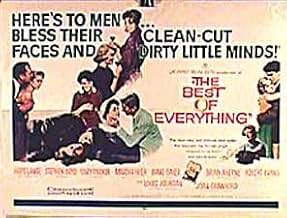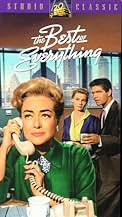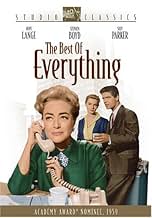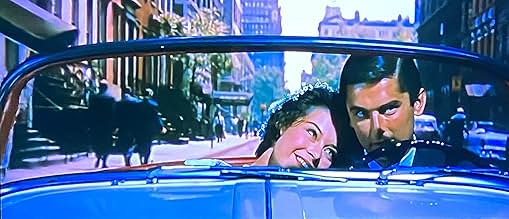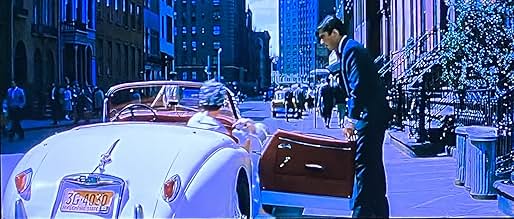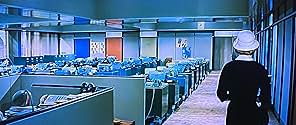IMDb-BEWERTUNG
6,6/10
2521
IHRE BEWERTUNG
Füge eine Handlung in deiner Sprache hinzuAn expose of the lives and loves of Madison Avenue working girls and their higher ups.An expose of the lives and loves of Madison Avenue working girls and their higher ups.An expose of the lives and loves of Madison Avenue working girls and their higher ups.
- Für 2 Oscars nominiert
- 2 Nominierungen insgesamt
Linda Hutchins
- Jane
- (as Linda Hutchings)
Ted Otis Sr.
- Dr. Ronnie Wood
- (as Ted Otis)
Gertrude Astor
- Leading Woman in Play
- (Nicht genannt)
Alan Austin
- Bill
- (Nicht genannt)
Joseph Bardo
- Policeman
- (Nicht genannt)
Empfohlene Bewertungen
The Best of Everything is a high gloss large screen soap opera which follows the careers of four career women, Hope Lange, Suzy Parker, Diane Baker, and Martha Hyer at a New York publishing firm. What's the best for some women is not necessarily the best for all.
Presiding over this group of young fillies is wise old mare Joan Crawford who's been around the track a few times on screen and in real life. She looks right at home as the boss lady as well she should have at this point.
Around the time she was making The Best of Everything Joan Crawford became a widow when her fourth husband, Alfred Steele died. It was a particularly traumatic event for her, she woke up one morning and found him dead in bed next to her. She inherited all of his stock in Pepsi Cola where he was the board chairman and during the same period as The Best of Everything was being made, she wound up the queen bee at Pepsi Cola. Life does sometimes imitate art. So that authority as she barks out dictation and coffee orders to Hope Lange rings real true.
In fact all the women here with the exception of Lange are in for some rough sledding. It's rough for Lange too, but she literally makes the best of everything.
What a collection of stinkers the men are in this film. The best of them, Stephen Boyd, is a heavy drinker. The others Louis Jourdan, Robert Evans, and Brett Halsey, are as slimy a collection of rodents as ever gathered for one film.
I can't forget Brian Aherne either who's the fanny pinching head of this publishing firm. Half that office would have sexual harassment suits going today.
Some nice location shots of New York in the fifties make the film a real treat. Catch it by all means.
Presiding over this group of young fillies is wise old mare Joan Crawford who's been around the track a few times on screen and in real life. She looks right at home as the boss lady as well she should have at this point.
Around the time she was making The Best of Everything Joan Crawford became a widow when her fourth husband, Alfred Steele died. It was a particularly traumatic event for her, she woke up one morning and found him dead in bed next to her. She inherited all of his stock in Pepsi Cola where he was the board chairman and during the same period as The Best of Everything was being made, she wound up the queen bee at Pepsi Cola. Life does sometimes imitate art. So that authority as she barks out dictation and coffee orders to Hope Lange rings real true.
In fact all the women here with the exception of Lange are in for some rough sledding. It's rough for Lange too, but she literally makes the best of everything.
What a collection of stinkers the men are in this film. The best of them, Stephen Boyd, is a heavy drinker. The others Louis Jourdan, Robert Evans, and Brett Halsey, are as slimy a collection of rodents as ever gathered for one film.
I can't forget Brian Aherne either who's the fanny pinching head of this publishing firm. Half that office would have sexual harassment suits going today.
Some nice location shots of New York in the fifties make the film a real treat. Catch it by all means.
More equality today, much more, but overall nothing has changed. All the sad, tawdry, pathetic, moving and bitter moments between women and men in the office is just as it is today, less the blatant sexual harassment. Love looking at old pics of nyc and looking in store windows....things seem surprisingly familiar and not dated.
A classic late 50's film. The superannuated headliners (Joan Crawford and Louis Jordan) are not at their best, but the direction, cinematography, and acting of the younger cast are compelling. In a 50's sense (which I love).
The look and feel of the artsy (over-artsy?) contemporary film "Far from heaven" reflects exactly this sort of film (and I suspect this film may be one of the models). A silly plot, of course (hey, it's 1959!), but as a film-- glorious! As a reflection of the society, extremely interesting. And as witness to how Hollywood breaks away from the idealistic portrayal of American sexual mores, fascinating.
The look and feel of the artsy (over-artsy?) contemporary film "Far from heaven" reflects exactly this sort of film (and I suspect this film may be one of the models). A silly plot, of course (hey, it's 1959!), but as a film-- glorious! As a reflection of the society, extremely interesting. And as witness to how Hollywood breaks away from the idealistic portrayal of American sexual mores, fascinating.
Claire Booth Luce's "The Women" shows relationships with men through a woman's point of view in a play, (and 1939 film that also has Joan Crawford playing a bitch: a character who might have been Amanda Farrow 20 years before), that has no male characters. Here we see the male characters and what a bunch they are. They use women like toys and throw them away, leaving the women to suffer. Ironically, the women in "The Women", perhaps because they are all we see, are shown in a less than favorable light, alternately silly and scheming, with the only "nice" one, (Norma Shearer), growing "claws" by the end. In "The Best of Everything" we see the men for the cads they are while the women are largely innocent and vulnerable.
This is a film about women leaping from things. Diane Baker leaps from a car, (in perhaps the most absurd scene in cinema history, which is not in the book). Suzy Parker falls from a fire escape. The women in the film are leaping into the workplace, looking for success and love at the same time. Women would leap into the future and leave this type of soap opera behind in the next decade. But they would come back to it in the 80's and 90's through the novels of people like Sidney Sheldon and Judith Krantz, (although their trashier works aren't as good as this).
The best thing about this film is the way it looks. I love the glossy cinemascope films of the 50's and 60's. They look so much better than the pixel-challenged home movies we've been making since, especially in the letterboxed version we see on TV, and the DVD, with the picture so clear you could walk into it. The look of the bevy of young beauties in it is also memorable. This film probably has more beautiful women in it than any other. It has a supermodel, (Suzy Parker), a beauty queen, (Myrna Hansen, who was not Miss America 1954 as Rona Jaffe says in the DVD commentary but rather Miss USA 1953, per the IMDb: but so what), and a Playboy playmate, (June Blair, from January 1957). My vote goes to Suzy, one of the astonishing beauties of all time. Her acting here isn't as awful as people pretend: they are just reacting, as people did then, to the sight of a supermodel, (the first, really), trying to act. Nobody seemed to care how well she did. Her role, that of an apparently worldly woman who turns out to be the most vulnerable, is the most complex in the bunch and she does just fine.
The most touching thing about the film now is the age of the female leads at the time. Hope Lange was 27 when they filmed this in the spring of 1959. Diane Baker was 20. Suzy Parker was 26. Hope, who looked to be Grace Kelly's heir, never made it really big and wound up being Mrs. Muir on television and, per the IMDb, wound up living in a home with "crates for coffee tables" because she spent her money on causes she believed in before dying at age 72 in 2003. This film must have seemed a very distant and irrelevant memory to her by then. Baker, always a welcome face in 60's TV, (especially to Richard Kimble), and still active as an actress and acting coach, just turned 67. Parker found "the best of everything" with Bradford Dillman for 40 years before dying at age 70 the same year Lange did. But here they are, young, beautiful and ambitious for success and love, just like their characters.
This is a film about women leaping from things. Diane Baker leaps from a car, (in perhaps the most absurd scene in cinema history, which is not in the book). Suzy Parker falls from a fire escape. The women in the film are leaping into the workplace, looking for success and love at the same time. Women would leap into the future and leave this type of soap opera behind in the next decade. But they would come back to it in the 80's and 90's through the novels of people like Sidney Sheldon and Judith Krantz, (although their trashier works aren't as good as this).
The best thing about this film is the way it looks. I love the glossy cinemascope films of the 50's and 60's. They look so much better than the pixel-challenged home movies we've been making since, especially in the letterboxed version we see on TV, and the DVD, with the picture so clear you could walk into it. The look of the bevy of young beauties in it is also memorable. This film probably has more beautiful women in it than any other. It has a supermodel, (Suzy Parker), a beauty queen, (Myrna Hansen, who was not Miss America 1954 as Rona Jaffe says in the DVD commentary but rather Miss USA 1953, per the IMDb: but so what), and a Playboy playmate, (June Blair, from January 1957). My vote goes to Suzy, one of the astonishing beauties of all time. Her acting here isn't as awful as people pretend: they are just reacting, as people did then, to the sight of a supermodel, (the first, really), trying to act. Nobody seemed to care how well she did. Her role, that of an apparently worldly woman who turns out to be the most vulnerable, is the most complex in the bunch and she does just fine.
The most touching thing about the film now is the age of the female leads at the time. Hope Lange was 27 when they filmed this in the spring of 1959. Diane Baker was 20. Suzy Parker was 26. Hope, who looked to be Grace Kelly's heir, never made it really big and wound up being Mrs. Muir on television and, per the IMDb, wound up living in a home with "crates for coffee tables" because she spent her money on causes she believed in before dying at age 72 in 2003. This film must have seemed a very distant and irrelevant memory to her by then. Baker, always a welcome face in 60's TV, (especially to Richard Kimble), and still active as an actress and acting coach, just turned 67. Parker found "the best of everything" with Bradford Dillman for 40 years before dying at age 70 the same year Lange did. But here they are, young, beautiful and ambitious for success and love, just like their characters.
Meant to be a glossy romance and cautionary tale for girls who dare to think of working Outside The Home, "The Best of Everything" instead is a virtual primer of the root causes of the modern Women's movement: Women (really, girls) can have jobs, but only until they find a man and leave to begin their real lives as homemakers; women are sexual toys, provided to men at work for their amusement; all men are predators and all women are fools; pregnancy is entirely the woman's fault; women who take their jobs seriously are damaged people; women merely exist for the use of men. Sounds like an unremitting screed, and it is -- yet, such is Hollywood's power, the pageant is very watchable (the clothes, the sentimental views of 1959 NYC) and beautiful. A wonderful snapshot of America just a couple of years before "The Feminine Mystique" was published. Must-see for women.
Wusstest du schon
- WissenswertesJoan Crawford, recently elected to the board of directors of Pepsi after the death of her husband who had been President and CEO of the company, managed to swing a brief quasi product plug for the soft drink by having an unmistakable Pepsi machine (with the red, white, and blue Pepsi logo, but sans the word "Pepsi") installed in the secretaries' on-screen break room.
- PatzerIn the scene when Diane Baker tells Hope Lange "he's ten foot tall to me" while walking down the street, several people... two men and two young boys... look into the camera, smiling (they were obviously filming with a camera hidden in a car during these scenes as those people weren't extras).
- Zitate
Amanda Farrow: Now you and your rabbit-faced wife can both go to hell!
- VerbindungenFeatured in Playboy's Penthouse: Folge #1.1 (1959)
- SoundtracksThe Best of Everything
by Sammy Cahn and Alfred Newman
Johnny Mathis sings during the opening credits
Also sung by a chorus at the end
Played often in the score
Top-Auswahl
Melde dich zum Bewerten an und greife auf die Watchlist für personalisierte Empfehlungen zu.
- How long is The Best of Everything?Powered by Alexa
Details
- Erscheinungsdatum
- Herkunftsland
- Sprache
- Auch bekannt als
- Las audaces
- Drehorte
- Produktionsfirmen
- Weitere beteiligte Unternehmen bei IMDbPro anzeigen
Box Office
- Budget
- 2.500.000 $ (geschätzt)
- Laufzeit2 Stunden 1 Minute
- Farbe
- Seitenverhältnis
- 2.35 : 1
Zu dieser Seite beitragen
Bearbeitung vorschlagen oder fehlenden Inhalt hinzufügen

Oberste Lücke
By what name was Alle meine Träume (1959) officially released in India in English?
Antwort

